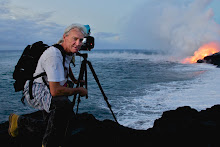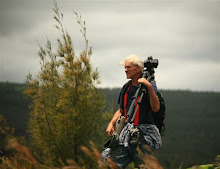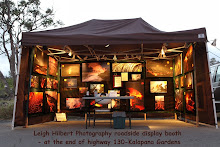


There are some indications of a new surge of eruption lava, which we have been watching as it worked its way down the Pulama Pali in the past few days, may now be converging with the April 2010 flow that reached the ocean April 29th.
One field report this morning noted an intensifying of surface lava leading into the old rock quarry that first began filling with pahoehoe last month on April 25th. I will check this out myself tonight.
After a fairly steady pressure of the magma beneath Kilauea volcano in the past two weeks, some deflation is now being recorded on the USGS deformation graphs:
In the past, deflation has translated into a lessoning of lava intensity in both the Halema’uma’u crater and from the Pu`u O`o eruption site, therefore weakening the surface flows leading to the coast.

Visitors that walked the mile from the Hawaii County roadside parking lot to the end of highway 130 designated lava viewing site last night reported only seeing a distant steam plume that glowed orange red at times after dark, as well as some lava glows on the distant pali, again, after dark. There was no active lava visible from the designated ‘viewing area’.
Previous Posts below still apply:
Active pahoehoe breakouts continue along with swelling of the hot flow fields at many locations of the April-May surface flow. The coastal entry points have changed somewhat in the past 24-hours, but are still emptying a lot of lava into the sea as new deltas area being rapidly built.
USGS lava flow map has been updated this morning:

And a new USGS image page has this good aerial of the lava off the (new) end of highway 130:

Below are two photos taken from nearly the same areas, see the captions below them:
 This photo was taken from the trailhead viewing area on April 25, 2010 of people watching the lava breaking out of the pali. Notice the Civil Defense sign on the bottom left between people’s legs—then see the sign, as it is this morning in the following photo.
This photo was taken from the trailhead viewing area on April 25, 2010 of people watching the lava breaking out of the pali. Notice the Civil Defense sign on the bottom left between people’s legs—then see the sign, as it is this morning in the following photo. Here is the same area early this morning: Trailhead Viewing Area under very hot and still swelling lava.
Here is the same area early this morning: Trailhead Viewing Area under very hot and still swelling lava.Below is yesterdays (May 8th) post, which remains up to date as far as the overall lava activity picture.
 (Click on any image for a larger view size in new window)
(Click on any image for a larger view size in new window)Lava continues well supplied from the eruption site near Pu`u O`o crater down the Pulama Pali; spreading out with active branches across the coastal flats and into the ocean in several locations along a half-mile of shoreline.
On the coast, pahoehoe continues actively flowing directly adjacent to the older Waikupanaha public viewing site; within 10-feet on the west & south sides and is now nearly level with that old viewing site.
Active lava breakouts are reportedly continuing very close by, but not onto, the paved end of highway 130. I do not know if visitors walking out to the latest public viewing location near the end of 130 were able to witness active lava there last night, or if they will see any tonight.
The Pulama Pali continues hosting an impressively broad and active advancement of new surface lava comprising of both A`a and pahoehoe. This latest flow may have burned into the April lava tubes and re-energized them. This is only my observation based on field activity on the pali and the resurgence of breakouts on the coastal flats and ocean entry the last few days.

Below is the timeline links to my posts for this April-May flow:
 (Click on any images for a larger view size)
(Click on any images for a larger view size)Above is a rough map with my added notes of the present lava situation (May 4th, 2010; lava has advanced beyond the marked in yellow locations in some places) on the coast of the Big Island. The aerial photo is from the April 28th, 2010 USGS image site.
Click on this link for a complete blog summary of this entire April, 2010 surface flow of lava; from mountain to sea: (scroll to the bottom and read each post running up for a chronological timeline)
And my most recent days postings for May, 2010
I will keep this as my main posting update layout in the coming days, adding new headings and images as lava events warrant.










No comments:
Post a Comment